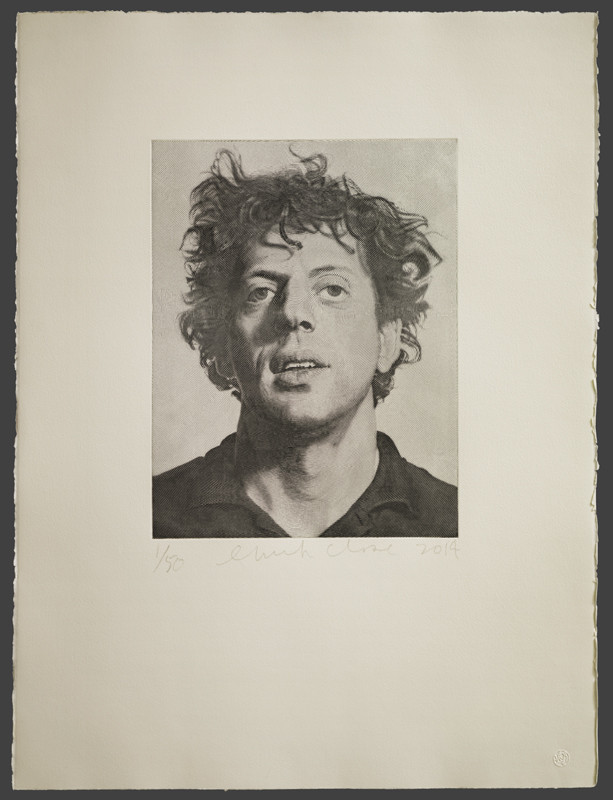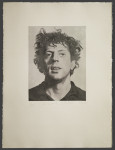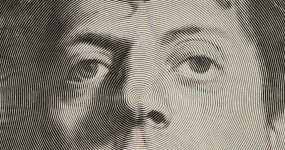
Magnolia Editions’ latest edition from Chuck Close is a tour de force of contemporary printmaking, but its origins lie in a masterpiece of engraving created almost three hundred years ago. “Phil (Spiral),” a portrait of Close’s friend and longtime subject, the modern composer Philip Glass, was inspired by the 17th-century French painter and engraver Claude Mellan’s print “The Sudarium” or “Veil of St Veronica.” Created in 1649, Mellan’s copper plate engraving proved so popular that it was posthumously reprinted well into the 18th century; in a 19th-century appreciation, writer Charles Sumner notes that in Mellan’s time, the print was thought to be inimitable.
Mellan’s “Sudarium” owes its fame to the artist’s remarkable use of a single line to engrave a realistic human face. Having studied traditional etching in Paris, Mellan spent twelve years in Rome refining the Italian engraving style, eventually dispensing entirely with the traditional cross-hatch marks of etching: in their place, Mellan began to employ a discrete, continuous line, which would gradually swell and taper to depict areas of light and dark. His most famous work, “The Sudarium” is based on an apocryphal story similar to that of the Shroud of Turin: a woman (St. Veronica) took pity on Jesus on the road to Calvary and wiped his sweating face with a cloth, to which the image of his features was miraculously transferred. The engraving achieves what S.W. Reed describes as “a miracle of a different sort[…] in a single line starting from the tip of Jesus’ nose, Mellan has engraved the entire face, the folded veil, and the lettering below. The modulations in direction, from thick to thin, model the image in chiaroscuro.”
As an artist who has created groundbreaking etchings for more than thirty years, Chuck Close was naturally touched by the singular achievement of Mellan’s “Sudarium,” even acquiring his own copy of the famous print. During a recent visit to Close’s New York studio, the artist proposed a challenge to Donald Farnsworth: could the contemporary printmaking wizardry of Magnolia Editions convincingly recreate the famed and apparently “inimitable” technique of one of the great French engravers? Farnsworth was more than happy to begin a series of experiments which, under Close’s direction, finally yielded a worthy homage to Mellan’s “Sudarium”: the crown-like curls and beatific gaze of a young Philip Glass, one of Close’s most frequent subjects, reproduced via copper plate etching using only a single engraved line emanating in a concentric spiral from the center of the composer’s nose.
Naturally, the route to a successful “Phil (Spiral)” etching was an indirect one, with many twists and turns: at first, Close and Farnsworth used a combination of digital engraving tools and algorithms to generate a series of largely unsatisfactory tests and to roughly identify areas of light and dark where the line would need to change shape. Ultimately, the single line making up the print had to be manipulated and adjusted entirely by hand over a period of several months. “The existing algorithms and programs can turn your image into a series of concentric circles,” explains Farnsworth, “but they give you none of the depth that makes Mellan’s print so impressive. To achieve that kind of dimensionality, the line has to traverse the topography of the face at angles that demand a radical departure from the spiral. Even the smallest single hair on Phil’s head required a corresponding, minute undulation in the line.”
This edition further exemplifies the breadth of Close’s arsenal of approaches to portraiture. Where many of the artist’s most well-known works use the grid as a device to effectively flatten the picture plane, removing any visual information regarding depth and presenting only a series of lights and darks, Farnsworth points out that the spiral print does just the opposite: here the artist is using an illusion of depth to depict the complex dimensionality of the face.
Printed at Magnolia Editions by master printer Nicholas Price in an edition of 50 and signed and numbered by the artist, “Phil (Spiral)” reflects an ongoing dialogue between printmaking’s past and future, into which Chuck Close and Magnolia Editions continue to introduce unexpected and exciting possibilities.
show prices
Prices and availability are subject to change without notice.The copyright of all art images belongs to the individual artists and Magnolia Editions, Inc.
©2003-2025 Magnolia Editions, Inc. All rights reserved. contact us


